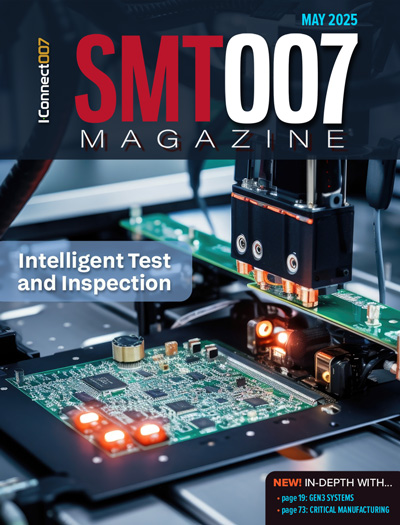-

-
News
News Highlights
- Books
Featured Books
- smt007 Magazine
Latest Issues
Current Issue
What's Your Sweet Spot?
Are you in a niche that’s growing or shrinking? Is it time to reassess and refocus? We spotlight companies thriving by redefining or reinforcing their niche. What are their insights?

Moving Forward With Confidence
In this issue, we focus on sales and quoting, workforce training, new IPC leadership in the U.S. and Canada, the effects of tariffs, CFX standards, and much more—all designed to provide perspective as you move through the cloud bank of today's shifting economic market.

Intelligent Test and Inspection
Are you ready to explore the cutting-edge advancements shaping the electronics manufacturing industry? The May 2025 issue of SMT007 Magazine is packed with insights, innovations, and expert perspectives that you won’t want to miss.
- Articles
- Columns
- Links
- Media kit
||| MENU - smt007 Magazine
The Right to a Safe, Healthy Work Environment
July 6, 2023 | Pamela Brody-Heine, Clean Electronics Production NetworkEstimated reading time: 1 minute
As we enter a new decade characterized by global transparency, companies are increasingly compelled to prioritize the protection of workers, not only within their own facilities but throughout complex multi-national supply chains. Process chemicals are increasingly being viewed as a human rights issue, as millions of workers in the electronics global supply chain are using process chemicals. The U.N. Special Rapporteur on Toxics (2018)1 reported that there are approximately 160 million cases of occupational disease reported annually across all industry sectors.
After recognizing the significance of safeguarding workers from hazardous chemicals in the manufacturing process, several companies joined forces in 2016 and collaborated with other stakeholders to form the Clean Electronics Production Network (CEPN).
CEPN is a multi-stakeholder innovation network working collectively to address complex workplace health and safety challenges in the electronics supply chain and proactively move the electronics industry toward safer and cleaner production to reduce worker exposure to process chemicals. The network comprises 20 member organizations, including major companies, suppliers, academia, environmental NGOs, labor representatives, ecolabels, and governmental agencies.
Members of CEPN recognize that process chemical management is an industry-wide issue and, given the complexity of electronics manufacturing supply chains, no single company or organization can tackle the issue of worker exposure to process chemicals alone; success requires the collective efforts of industry leaders. Suppliers serve multiple customers, for example, and major companies share many suppliers. Only by working together can companies move toward zero exposure of workers to toxic chemicals. Protecting workers from exposure to hazardous chemicals is a complex, global issue which stretches throughout a supply chain that is shared and globally distributed.
Early in the formation of CEPN, members recognized the need to focus on process chemicals in the electronics industry, as much of the attention to-date—regulations, ecolabels, standards, voluntary efforts, etc.—had been on product chemicals (those chemicals incorporated into final products). Hence, CEPN’s primary focus is on reducing exposure to process chemicals, those chemicals used during product manufacturing and the maintenance of related production equipment but are not intentionally fully incorporated into the final product. Examples of process chemicals include cleaning agents, solvents, lubricants, photochemicals, plating agents, refrigerants, hydraulic fluids, adhesives, inks, and coatings, among others.
To read this entire article, which appeared in the June 2023 issue of SMT007 Magazine, click here.
Suggested Items
The Global Electronics Association Releases IPC-8911: First-Ever Conductive Yarn Standard for E-Textile Application
07/02/2025 | Global Electronics AssociationThe Global Electronics Association announces the release of IPC-8911, Requirements for Conductive Yarns for E-Textiles Applications. This first-of-its-kind global standard establishes a clear framework for classifying, designating, and qualifying conductive yarns—helping to address longstanding challenges in supply chain communication, product testing, and material selection within the growing e-textiles industry.
Eiyu Electronics Launches Pre-Assembled Module Product Line to Simplify Sourcing for Embedded Projects
07/02/2025 | BUSINESS WIREEiyu Electronics Co., Ltd., a Hong Kong-based electronic component trading company, today announced the official launch of its pre-assembled module product line, designed to help engineers and procurement teams save time when sourcing complex modular components.
Kitron Receives EUR 4 Million Contract for Defense Airborne Radar Application
07/02/2025 | KitronKitron has received an order valued at EUR 4 million to produce electronics modules for airborne radar application, destined for the US market.
Horizon Sales Celebrates 10 Years of Exceptional Service by Sales Leader David Smith
07/02/2025 | Horizon SalesHorizon Sales, a premier manufacturers’ representative and distributor for the electronics assembly industry, is proud to announce that David Smith is celebrating 10 years with the company this month.
Symposium Review: Qnity, DuPont, and Insulectro Forge Ahead with Advanced Materials
07/02/2025 | Barb Hockaday, I-Connect007In a dynamic and informative Innovation Symposium hosted live and on Zoom on June 25, 2025, representatives from Qnity (formerly DuPont Electronics), DuPont, and Insulectro discussed the evolving landscape of flexible circuit materials. From strategic corporate changes to cutting-edge polymer films, the session offered deep insight into design challenges, reliability, and next-gen solutions shaping the electronics industry.


